Sonoelectrochemical Nanoarchitectonics of Crystalline Mesoporous Magnetite @ Manganese Oxide Nanocomposite as an Alternate Anode Material for Energy-Storage Applications
Abstract
1. Introduction
2. Materials and Methods
2.1. Sonoelectrochemical Nanoarchitectonic Synthesis of m-Fe3O4@MnO2 Hybrid Nanostructure
2.2. Material Characterizations
2.3. Electrochemical Characterization
3. Results and Discussion
3.1. Element-Based Purity Test
3.2. Presence of Elements in the Nanocomposite
3.3. Material Characteristics of m-Fe3O4 and m-Fe3O4@MnO2
3.4. Electrochemical Performance of m-Fe3O4 and m-Fe3O4@MnO2
4. Conclusions
Author Contributions
Funding
Data Availability Statement
Acknowledgments
Conflicts of Interest
References
- Rahman, M.M.; Oni, A.O.; Gemechu, E.; Kumar, A. Assessment of Energy Storage Technologies: A Review. Energy Convers. Manag. 2020, 223, 113295. [Google Scholar] [CrossRef]
- Kim, T.; Song, W.; Son, D.-Y.; Ono, L.K.; Qi, Y. Lithium-Ion Batteries: Outlook on Present, Future, and Hybridized Technologies. J. Mater. Chem. A 2019, 7, 2942–2964. [Google Scholar] [CrossRef]
- Ghalkhani, M.; Habibi, S. Review of the Li-Ion Battery, Thermal Management, and AI-Based Battery Management System for EV Application. Energies 2023, 16, 185. [Google Scholar] [CrossRef]
- Yoshino, A. The Lithium-Ion Battery: Two Breakthroughs in Development and Two Reasons for the Nobel Prize. BCSJ 2022, 95, 195–197. [Google Scholar] [CrossRef]
- Ariga, K. Nanoarchitectonics: What’s Coming next after Nanotechnology? Nanoscale Horiz. 2021, 6, 364–378. [Google Scholar] [CrossRef]
- Zhang, H.; Yang, Y.; Ren, D.; Wang, L.; He, X. Graphite as Anode Materials: Fundamental Mechanism, Recent Progress and Advances. Energy Storage Mater. 2021, 36, 147–170. [Google Scholar] [CrossRef]
- Qi, S.; Xu, B.; Tiong, V.T.; Hu, J.; Ma, J. Progress on Iron Oxides and Chalcogenides as Anodes for Sodium-Ion Batteries. Chem. Eng. J. 2020, 379, 122261. [Google Scholar] [CrossRef]
- Yew, Y.P.; Shameli, K.; Miyake, M.; Ahmad Khairudin, N.B.B.; Mohamad, S.E.B.; Naiki, T.; Lee, K.X. Green Biosynthesis of Superparamagnetic Magnetite Fe3O4 Nanoparticles and Biomedical Applications in Targeted Anticancer Drug Delivery System: A Review. Arab. J. Chem. 2020, 13, 2287–2308. [Google Scholar] [CrossRef]
- Tadesse, A.; RamaDevi, D.; Hagos, M.; Battu, G.; Basavaiah, K. Synthesis of Nitrogen Doped Carbon Quantum Dots/Magnetite Nanocomposites for Efficient Removal of Methyl Blue Dye Pollutant from Contaminated Water. RSC Adv. 2018, 8, 8528–8536. [Google Scholar] [CrossRef]
- Masudi, A.; Harimisa, G.E.; Ghafar, N.A.; Jusoh, N.W.C. Magnetite-Based Catalysts for Wastewater Treatment. Environ. Sci. Pollut. Res. 2020, 27, 4664–4682. [Google Scholar] [CrossRef]
- Wadhawan, S.; Jain, A.; Nayyar, J.; Mehta, S.K. Role of Nanomaterials as Adsorbents in Heavy Metal Ion Removal from Waste Water: A Review. J. Water Process Eng. 2020, 33, 101038. [Google Scholar] [CrossRef]
- Niculescu, A.-G.; Chircov, C.; Grumezescu, A.M. Magnetite Nanoparticles: Synthesis Methods—A Comparative Review. Methods 2022, 199, 16–27. [Google Scholar] [CrossRef] [PubMed]
- Cabrera, L.; Gutiérrez, S.; Herrasti, P.; Reyman, D. Sonoelectrochemical Synthesis of Magnetite. Phys. Procedia 2010, 3, 89–94. [Google Scholar] [CrossRef]
- Zore, U.K.; Yedire, S.G.; Pandi, N.; Manickam, S.; Sonawane, S.H. A Review on Recent Advances in Hydrogen Energy, Fuel Cell, Biofuel and Fuel Refining via Ultrasound Process Intensification. Ultrason. Sonochem. 2021, 73, 105536. [Google Scholar] [CrossRef] [PubMed]
- Sivasankar, T.; Paunikar, A.W.; Moholkar, V.S. Mechanistic Approach to Enhancement of the Yield of a Sonochemical Reaction. AIChE J. 2007, 53, 1132–1143. [Google Scholar] [CrossRef]
- Cheng, H.; Shapter, J.G.; Li, Y.; Gao, G. Recent Progress of Advanced Anode Materials of Lithium-Ion Batteries. J. Energy Chem. 2021, 57, 451–468. [Google Scholar] [CrossRef]
- Gao, T.; Xu, C.; Li, R.; Zhang, R.; Wang, B.; Jiang, X.; Hu, M.; Bando, Y.; Kong, D.; Dai, P.; et al. Biomass-Derived Carbon Paper to Sandwich Magnetite Anode for Long-Life Li-Ion Battery. ACS Nano 2019, 13, 11901–11911. [Google Scholar] [CrossRef]
- Chen, Q.; Wei, W.; Tang, J.; Lin, J.; Li, S.; Zhu, M. Dopamine-Assisted Preparation of Fe3O4@MnO2 Yolk@shell Microspheres for Improved Pseudocapacitive Performance. Electrochim. Acta 2019, 317, 628–637. [Google Scholar] [CrossRef]
- Minakshi, M.; Mitchell, D.; Prince, K. Incorporation of TiB2 Additive into MnO2 Cathode and Its Influence on Rechargeability in an Aqueous Battery System. Solid State Ionics 2008, 179, 355–361. [Google Scholar] [CrossRef]
- Biswal, A.; Panda, P.K.; Acharya, A.N.; Mohapatra, S.; Swain, N.; Tripathy, B.C.; Jiang, Z.-T.; Minakshi Sundaram, M. Role of Additives in Electrochemical Deposition of Ternary Metal Oxide Microspheres for Supercapacitor Applications. ACS Omega 2020, 5, 3405–3417. [Google Scholar] [CrossRef]
- Minakshi, M.; Singh, P.; Mitchell, D.R.G.; Issa, T.B.; Prince, K. A Study of Lithium Insertion into MnO2 Containing TiS2 Additive a Battery Material in Aqueous LiOH Solution. Electrochim. Acta 2007, 52, 7007–7013. [Google Scholar] [CrossRef]
- Minakshi, M.; Pandey, A.; Blackford, M.; Ionescu, M. Effect of TiS2 Additive on LiMnPO4 Cathode in Aqueous Solutions. Energy Fuels 2010, 24, 6193–6197. [Google Scholar] [CrossRef]
- Manickam, M.; Takata, M. Electrochemical and X-Ray Photoelectron Spectroscopy Studies of Carbon Black as an Additive in Li Batteries. J. Power Sources 2002, 112, 116–120. [Google Scholar] [CrossRef]
- Minakshi, M.; Singh, P.; Mitchell, D.R. Manganese Dioxide Cathode in the Presence of TiS2 as Additive on an Aqueous Lithium Secondary Cell. J. Electrochem. Soc. 2007, 154, A109. [Google Scholar] [CrossRef]
- Kalidass, J.; Sivasankar, T. Facile One-Pot Rapid Sonoelectrochemical Synthesis of Mesoporous Magnetite Nanospheres: A Chimie Douce Approach. Mater. Chem. Phys. 2023, 301, 127620. [Google Scholar] [CrossRef]
- Kalidass, J.; Sivasankar, T. Mesoporous Core/Shell MnFe2O4 Nanocomposite Derived from Facile Sonoelectrochemical Process: An Eco-Friendly Method for Rapid Synthesis and Versatile Industrial Applications. J. Taiwan Inst. Chem. Eng. 2023, 144, 104766. [Google Scholar] [CrossRef]
- Dong, X.; Wang, J.; Miao, J.; Ren, B.; Wang, X.; Zhang, L.; Liu, Z.; Xu, Y. Fe3O4/MnO2 Co-Doping Phenolic Resin Porous Carbon for High Performance Supercapacitors. J. Taiwan Inst. Chem. Eng. 2022, 135, 104385. [Google Scholar] [CrossRef]
- Dubey, M.; Challagulla, N.V.; Kumar, R. Synergistic Engineering for Adsorption Assisted Photodegradation of 2,4 Dichlorophenol Using Easily Recoverable ɑ-MnO2/Fe3O4 Nanocomposite. Appl. Surf. Sci. Adv. 2022, 11, 100300. [Google Scholar] [CrossRef]
- Zhang, H.; He, Y.; Lai, L.; Yao, G.; Lai, B. Catalytic Ozonation of Bisphenol A in Aqueous Solution by Fe3O4-MnO2 Magnetic Composites: Performance, Transformation Pathways and Mechanism. Sep. Purif. Technol. 2020, 245, 116449. [Google Scholar] [CrossRef]
- Dong, Z.; Zhang, Q.; Chen, B.-Y.; Hong, J. Oxidation of Bisphenol A by Persulfate via Fe3O4-α- MnO2 Nanoflower-like Catalyst: Mechanism and Efficiency. Chem. Eng. J. 2019, 357, 337–347. [Google Scholar] [CrossRef]
- Xiong, Y.; Chen, S.; Ye, F.; Su, L.; Zhang, C.; Shen, S.; Zhao, S. Preparation of Magnetic Core–Shell Nanoflower Fe3O4@MnO2 as Reusable Oxidase Mimetics for Colorimetric Detection of Phenol. Anal. Methods 2015, 7, 1300–1306. [Google Scholar] [CrossRef]
- Zhang, C.; Jin, C.; Teng, G.; Gu, Y.; Ma, W. Controllable Synthesis of Hollow MnFe2O4 by Self-Etching and Its Application in High-Performance Anode for Lithium-Ion Batteries. Chem. Eng. J. 2019, 365, 121–131. [Google Scholar] [CrossRef]
- Wang, N.; Ma, X.; Wang, Y.; Yang, J.; Qian, Y. Porous MnFe2O4 Microrods as Advanced Anodes for Li-Ion Batteries with Long Cycle Lifespan. J. Mater. Chem. A 2015, 3, 9550–9555. [Google Scholar] [CrossRef]
- Yang, Z.; Huang, Y.; Ji, D.; Xiong, G.; Luo, H.; Wan, Y. Hydrazine Hydrate-Induced Hydrothermal Synthesis of MnFe2O4 Nanoparticles Dispersed on Graphene as High-Performance Anode Material for Lithium Ion Batteries. Ceram. Int. 2017, 43, 10905–10912. [Google Scholar] [CrossRef]
- Tang, H.; Gao, P.; Xing, A.; Tian, S.; Bao, Z. One-Pot Low-Temperature Synthesis of a MnFe2O4–Graphene Composite for Lithium Ion Battery Applications. RSC Adv. 2014, 4, 28421–28425. [Google Scholar] [CrossRef]
- Wang, F.; Li, T.; Fang, Y.; Wang, Z.; Zhu, J. Heterogeneous Structured Mn2O3/Fe2O3 Composite as Anode Material for High Performance Lithium Ion Batteries. J. Alloys Compd. 2021, 857, 157531. [Google Scholar] [CrossRef]
- Wang, D.; Wang, Y.; Li, Q.; Guo, W.; Zhang, F.; Niu, S. Urchin-like α-Fe2O3/MnO2 Hierarchical Hollow Composite Microspheres as Lithium-Ion Battery Anodes. J. Power Sources 2018, 393, 186–192. [Google Scholar] [CrossRef]
- Fu, Y.; Wang, X.; Wang, H.; Zhang, Y.; Yang, X.; Shu, H. An Fe3O4@(C–MnO2) Core–Double-Shell Composite as a High-Performance Anode Material for Lithium Ion Batteries. RSC Adv. 2015, 5, 14531–14539. [Google Scholar] [CrossRef]
- Guan, B.; Sun, W.; Wang, Y. Carbon-Coated MnMoO4 Nanorod for High-Performance Lithium-Ion Batteries. Electrochim. Acta 2016, 190, 354–359. [Google Scholar] [CrossRef]
- Minakshi, M.; Barmi, M.; Mitchell, D.R.; Barlow, A.J.; Fichtner, M. Effect of Oxidizer in the Synthesis of NiO Anchored Nanostructure Nickel Molybdate for Sodium-Ion Battery. Mater. Today Energy 2018, 10, 1–14. [Google Scholar] [CrossRef]
- Chu, Y.; Shi, X.; Wang, Y.; Fang, Z.; Deng, Y.; Liu, Z.; Dong, Q.; Hao, Z. High Temperature Solid-State Synthesis of Dopant-Free Fe2Mo3O8 for Lithium-Ion Batteries. Inorg. Chem. Commun. 2019, 107, 107477. [Google Scholar] [CrossRef]
- Xue, R.; Hong, W.; Pan, Z.; Jin, W.; Zhao, H.; Song, Y.; Zhou, J.; Liu, Y. Enhanced Electrochemical Performance of ZnMoO4/Reduced Graphene Oxide Composites as Anode Materials for Lithium-Ion Batteries. Electrochim. Acta 2016, 222, 838–844. [Google Scholar] [CrossRef]
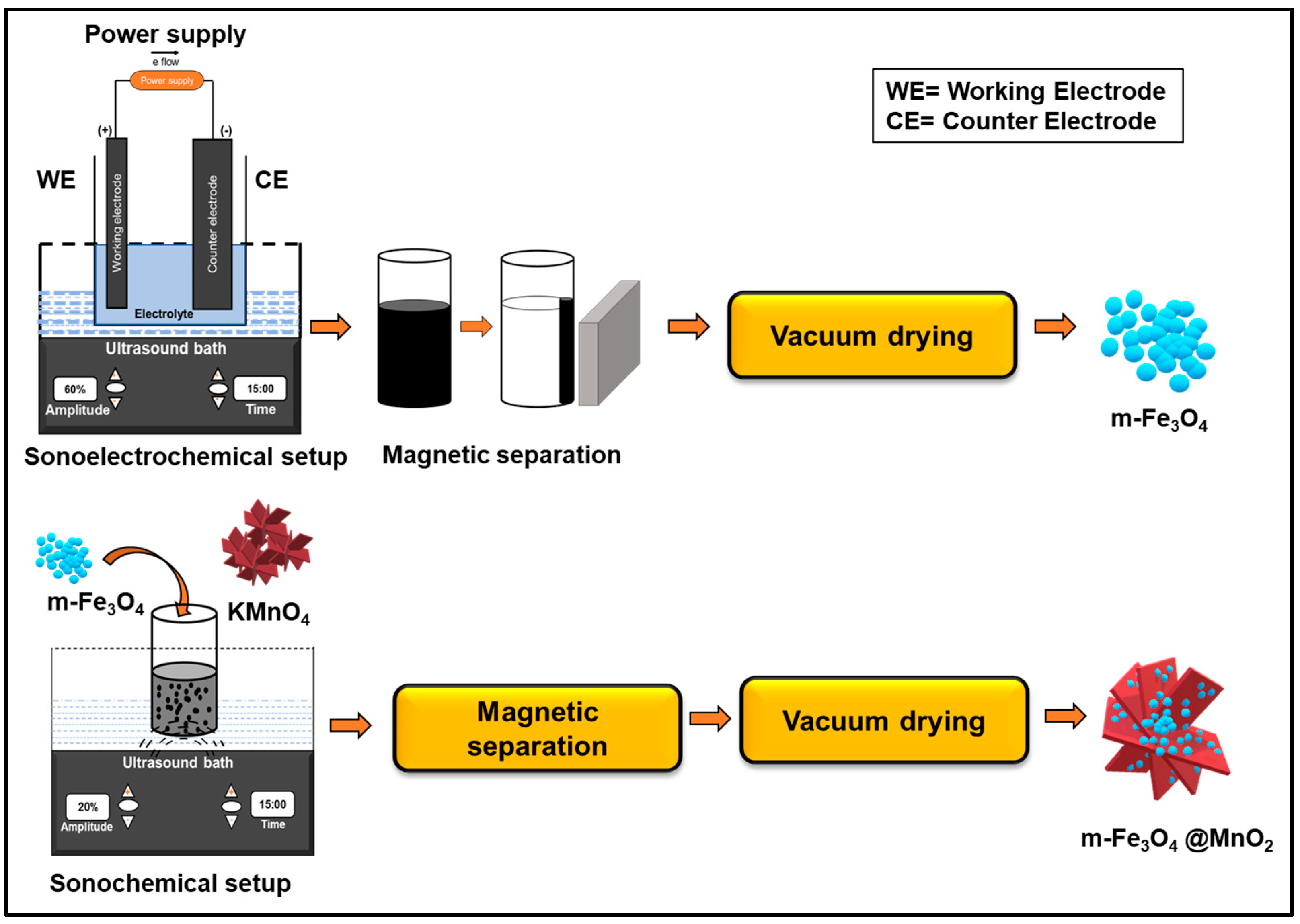
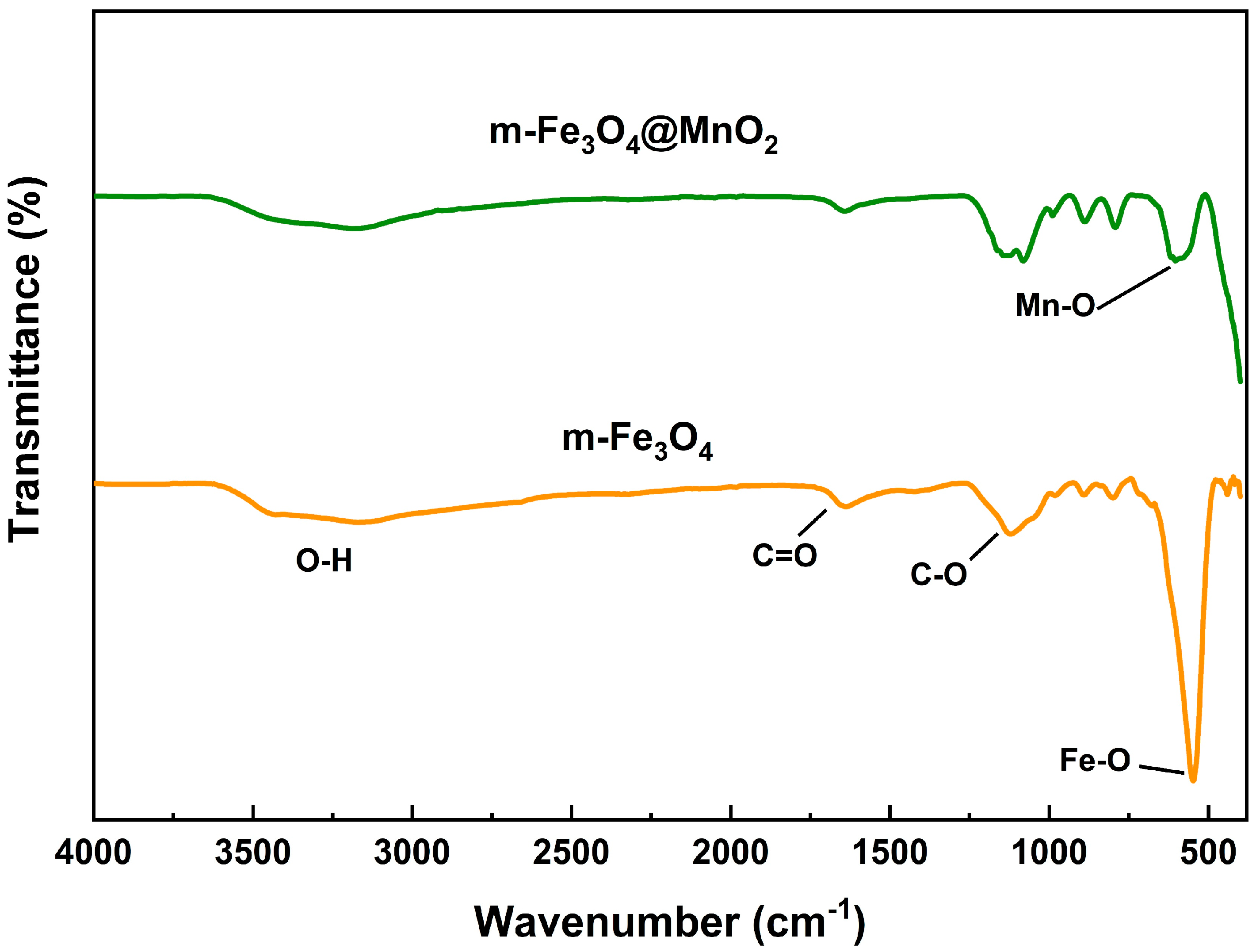
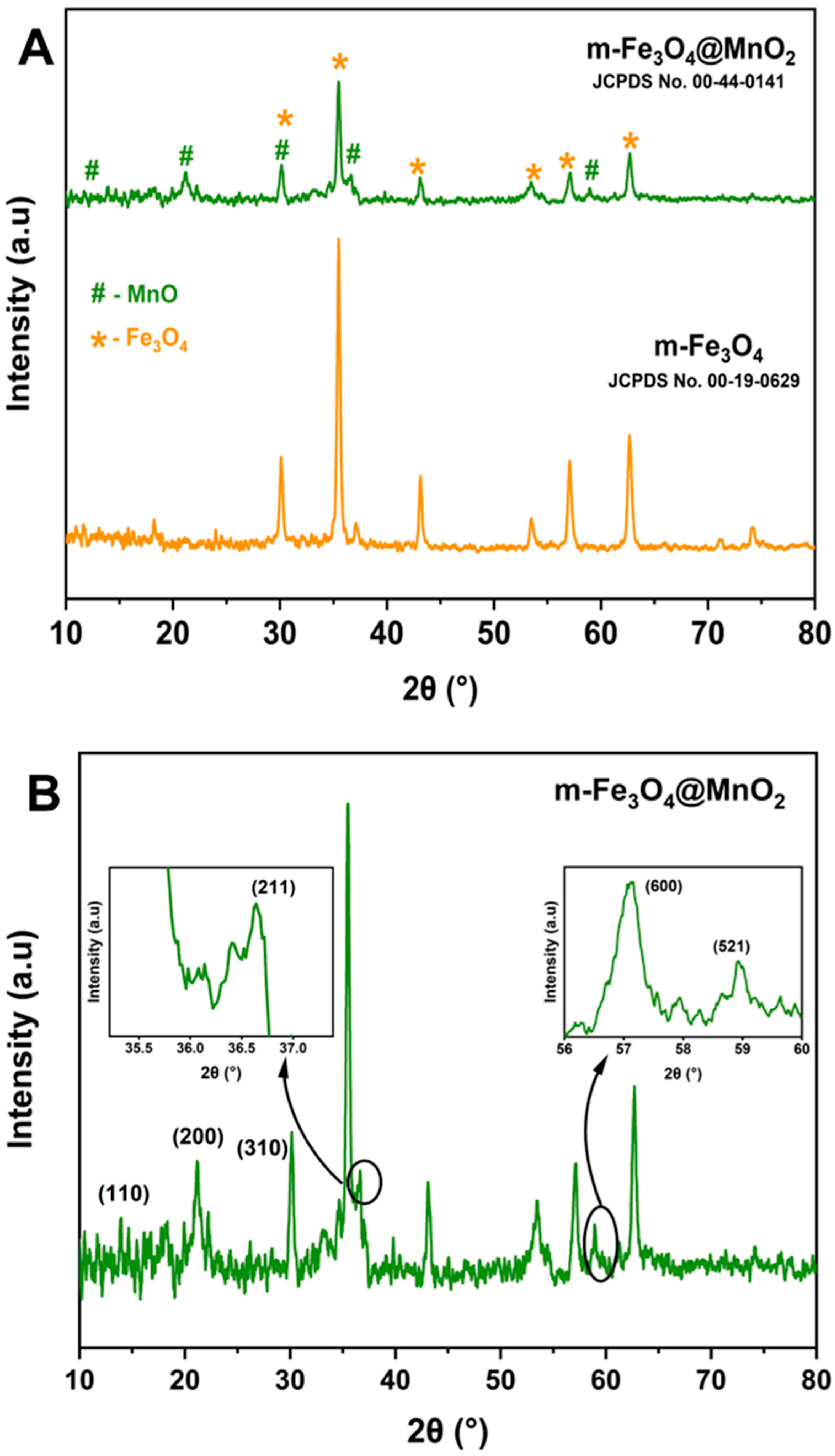


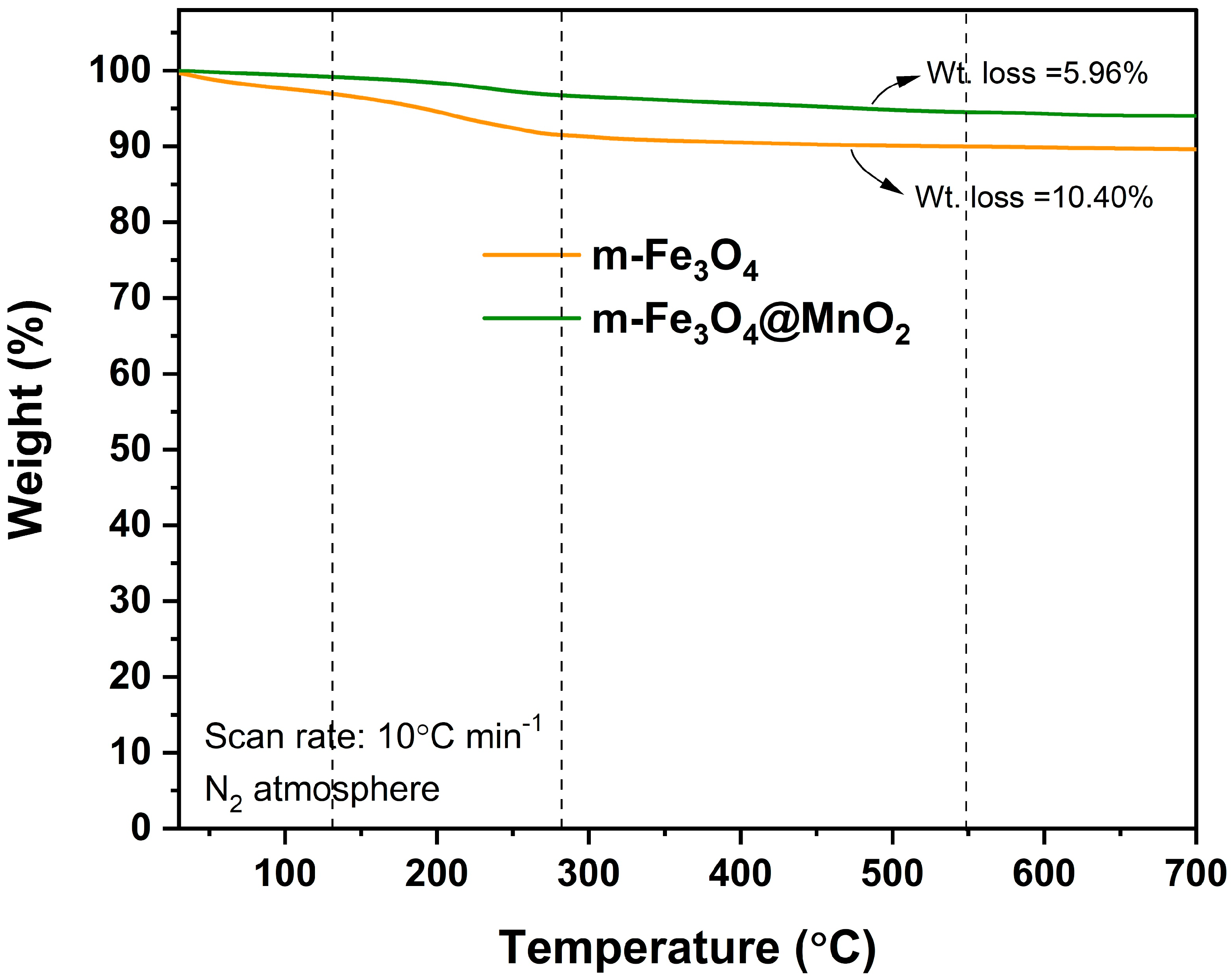
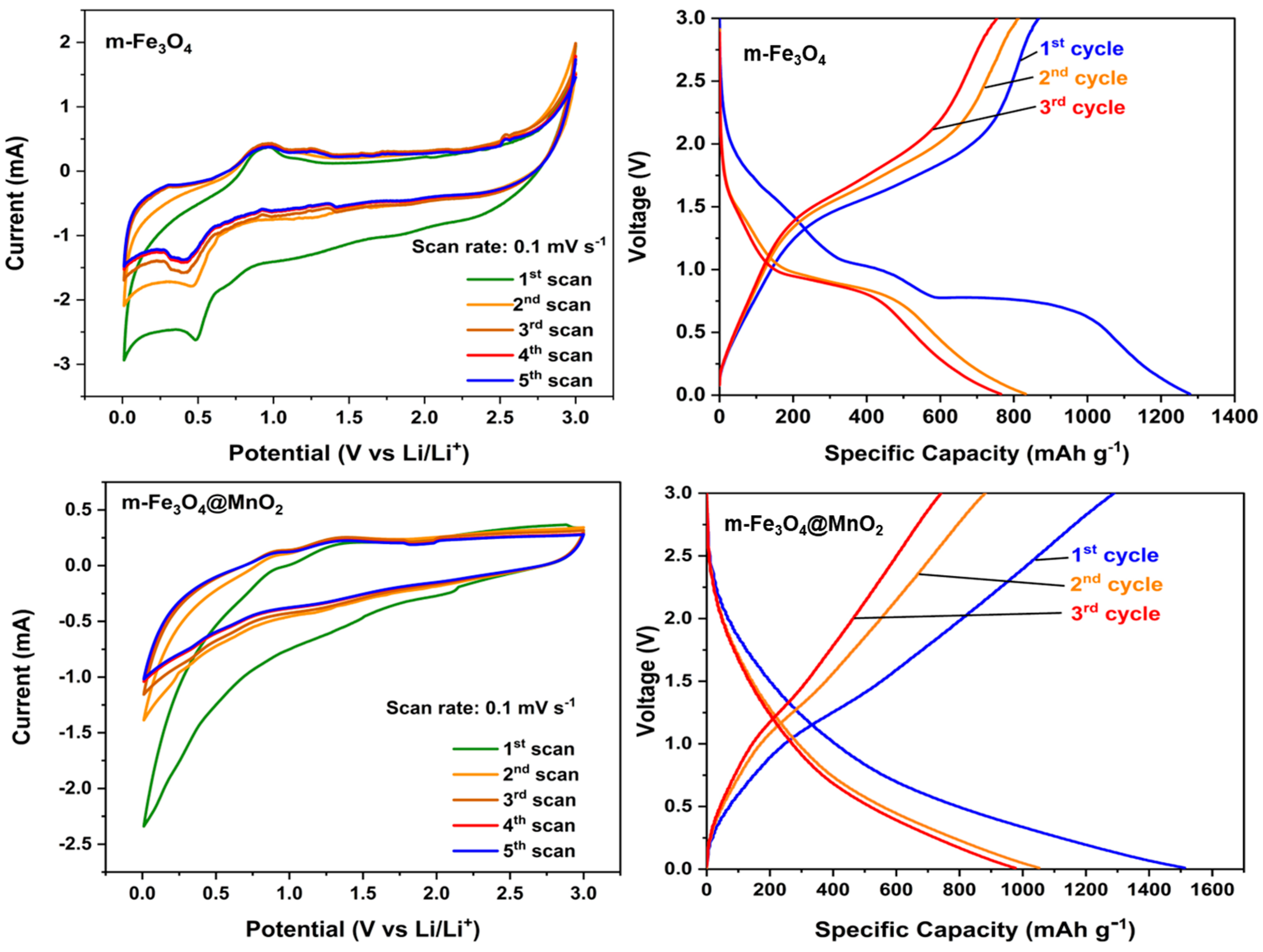
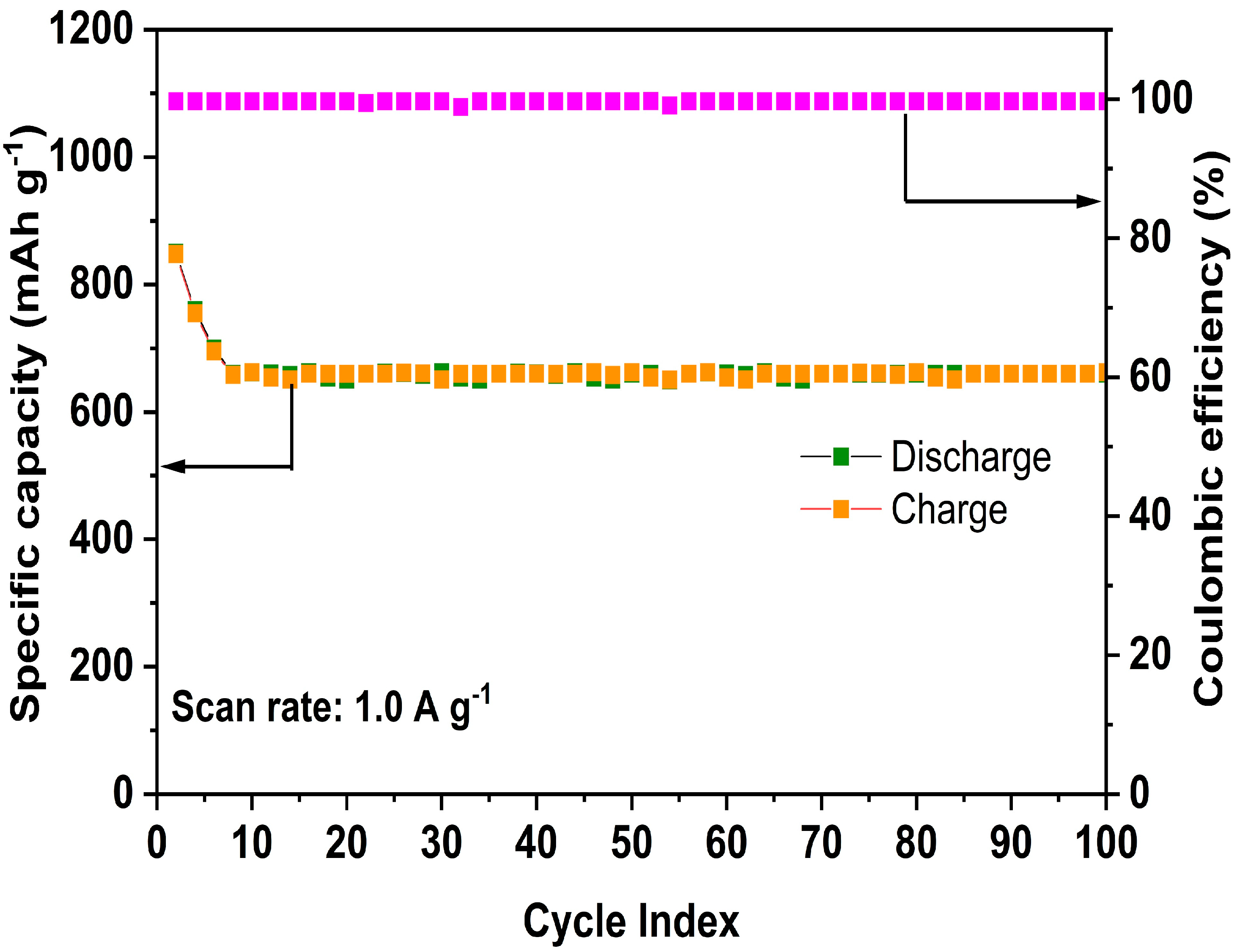
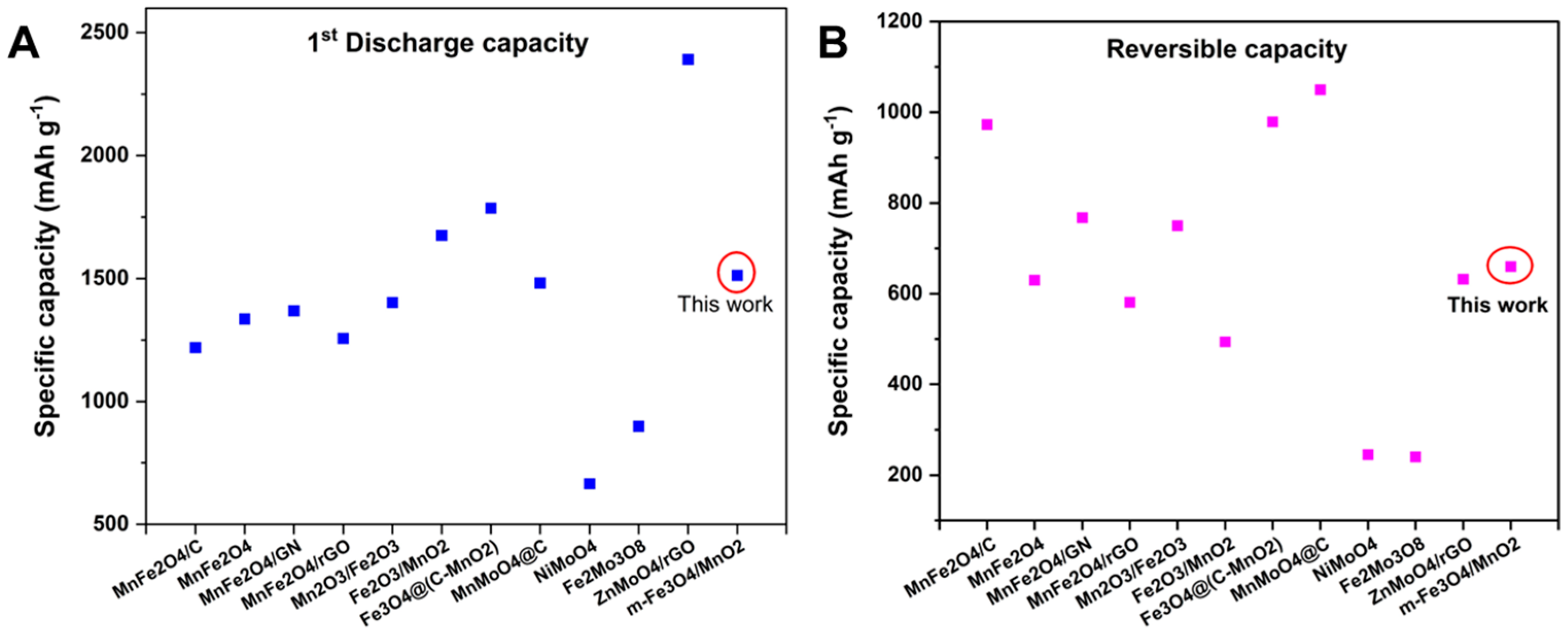
| Material | Method | Synthesis Time | Temp. (°C) | Atmosphere | Size | Surface Area (m2 g−1) | Application | Reference | |
|---|---|---|---|---|---|---|---|---|---|
| Fe3O4 (nm) | MnO2 (nm) | ||||||||
| PR-Fe@MnO2 | Carbonization | 2 h | 800 °C | N2 | - | - | 1073 | Supercapacitor | [27] |
| α-MnO2/Fe3O4 nanocomposite | Hydrothermal | 4 h | 110 °C | Open | 22 ± 5 | 50 ± 10 dia., ~1 μ length | - | Degradation | [28] |
| Fe3O4-MnO2 | Co-precipitation | 2 h | 70 °C | Open | - | - | 127 | Catalyst | [29] |
| Fe3O4-α-MnO2 nanoflower | Hydrothermal | 2 + 10 h | 80 °C, 120 °C | Open | 50–60 | - | - | Catalyst | [30] |
| Core-shell nanoflowers Fe3O4@MnO2 | Solvothermal | 8 + 6 h | 200 °C, 120 °C | Open | - | - | - | Detector | [31] |
| m-Fe3O4@MnO2 hybrid nanostructure | Sonoelectrochemical | 15 + 15 min | 60 °C | Open | 45 ± 10 | 420 + 30 | 385.7 | Anode | This paper |
| Material | Structure | Synthesis Method | Synthesis Duration | 1st Cycle | Cyclic Stability | Ref. | ||||
|---|---|---|---|---|---|---|---|---|---|---|
| Cd | CDischarge | CCharge | Cycles | Cd | CRev | |||||
| A g−1 | mAh g−1 | mAh g−1 | A g−1 | mAh g−1 | ||||||
| MnFe2O4/C | Hollow nanospheres | Hydrothermal, carbonization, self-etching | 200 °C for 8 h 160 °C for 4 h RT for 15 h | 0.2 | 1219 | ~980 | 60 | 0.2 | 973 | [32] |
| MnFe2O4 | Porous microrods | Microemulsion, annealing | RT for 9 h 500 °C for 2 h | - | 1336 | ~937 | 1000 | 1 | 630 | [33] |
| MnFe2O4/GN | NPs decorated on sheet | Hydrothermal | 180 °C for 12 h | 0.2 | 1369 | 838 | 200 | 1 | 768 | [34] |
| MnFe2O4/rGO | NPs decorated on sheet | Co-precipitation | 90 °C for 4 h | 0.05 | 1256.5 | 794 | 200 | 1 | 581.2 | [35] |
| Mn2O3/Fe2O3 | Microspheres | Solvothermal and annealing | 150 °C for 12 h, 800 °C for 5 h | 1 | 1403 | 886 | 500 | 1 | 750 | [36] |
| Fe2O3/MnO2 | Microspheres | Hydrothermal | 600 °C for 3 h 80 °C for 4 h 600 °C for 3 h | 0.1 | 1675.6 | 1051.3 | 500 | 0.5 | 494 | [37] |
| Fe3O4@(C-MnO2) | Cubic encapsulation | Hydrothermal, sintering, ultrasonication | 180 °C for 6 h, 400 °C for 3 h, 600 °C for 4 h, 180 °C for 6 h | 0.1 | 1786 | ~1200 | 150 | 0.1 | 979 | [38] |
| MnMoO4@C | Nanorods | Precipitation, calcination, hydrothermal | RT for 1 h, 500 °C for 3 h, 180 °C for 12 h | 0.1C | 1482 | 1021 | 200 | 0.1 | 1050 | [39] |
| NiMoO4 | Nanordods | Solution combustion | 300 °C for 3 h | 0.05 | 665 | 365 | 100 | 0.05 | 245 | [40] |
| Fe2Mo3O8 | Block-like structure | High-temperature solid-state reaction | 1000 °C for 8 h under 8 MPa pressure | 0.05 | 898.7 | ~870 | 800 | 0.5 | 240 | [41] |
| ZnMoO4/rGO | Irregular plate | Hydrothermal | 160 °C for 8 h | 0.1 | 2391.2 | ~850 | 100 | 0.1 | 632 | [42] |
| m-Fe3O4/MnO2 | NPs decorated on sheet | Sonoelectrochemical | 60 °C for 15 min RT for 15 min | 0.2 | 1513 | 1290 | 100 | 1 | 660 | This work |
Disclaimer/Publisher’s Note: The statements, opinions and data contained in all publications are solely those of the individual author(s) and contributor(s) and not of MDPI and/or the editor(s). MDPI and/or the editor(s) disclaim responsibility for any injury to people or property resulting from any ideas, methods, instructions or products referred to in the content. |
© 2023 by the authors. Licensee MDPI, Basel, Switzerland. This article is an open access article distributed under the terms and conditions of the Creative Commons Attribution (CC BY) license (https://creativecommons.org/licenses/by/4.0/).
Share and Cite
Kalidass, J.; Anandan, S.; Sivasankar, T. Sonoelectrochemical Nanoarchitectonics of Crystalline Mesoporous Magnetite @ Manganese Oxide Nanocomposite as an Alternate Anode Material for Energy-Storage Applications. Crystals 2023, 13, 557. https://doi.org/10.3390/cryst13040557
Kalidass J, Anandan S, Sivasankar T. Sonoelectrochemical Nanoarchitectonics of Crystalline Mesoporous Magnetite @ Manganese Oxide Nanocomposite as an Alternate Anode Material for Energy-Storage Applications. Crystals. 2023; 13(4):557. https://doi.org/10.3390/cryst13040557
Chicago/Turabian StyleKalidass, Jayaraman, Sambandam Anandan, and Thirugnanasambandam Sivasankar. 2023. "Sonoelectrochemical Nanoarchitectonics of Crystalline Mesoporous Magnetite @ Manganese Oxide Nanocomposite as an Alternate Anode Material for Energy-Storage Applications" Crystals 13, no. 4: 557. https://doi.org/10.3390/cryst13040557
APA StyleKalidass, J., Anandan, S., & Sivasankar, T. (2023). Sonoelectrochemical Nanoarchitectonics of Crystalline Mesoporous Magnetite @ Manganese Oxide Nanocomposite as an Alternate Anode Material for Energy-Storage Applications. Crystals, 13(4), 557. https://doi.org/10.3390/cryst13040557







